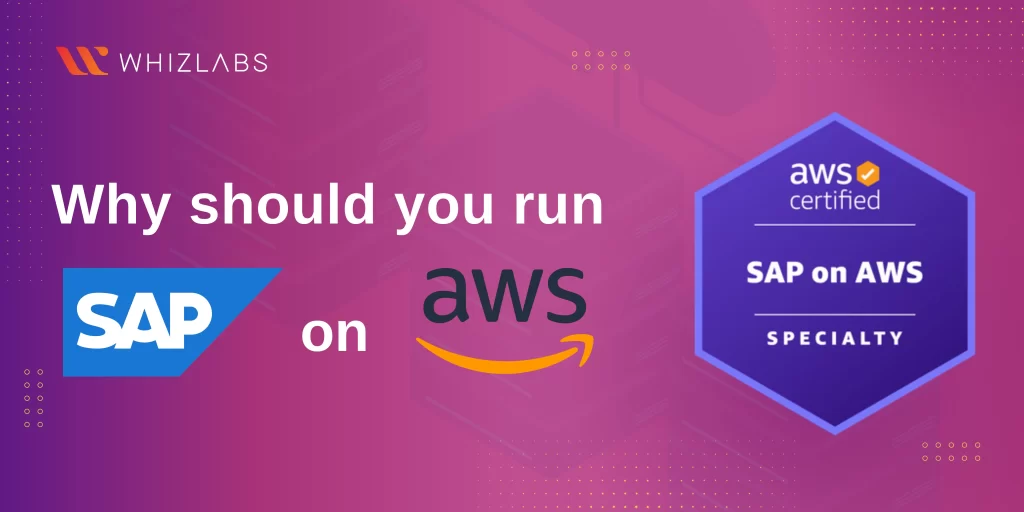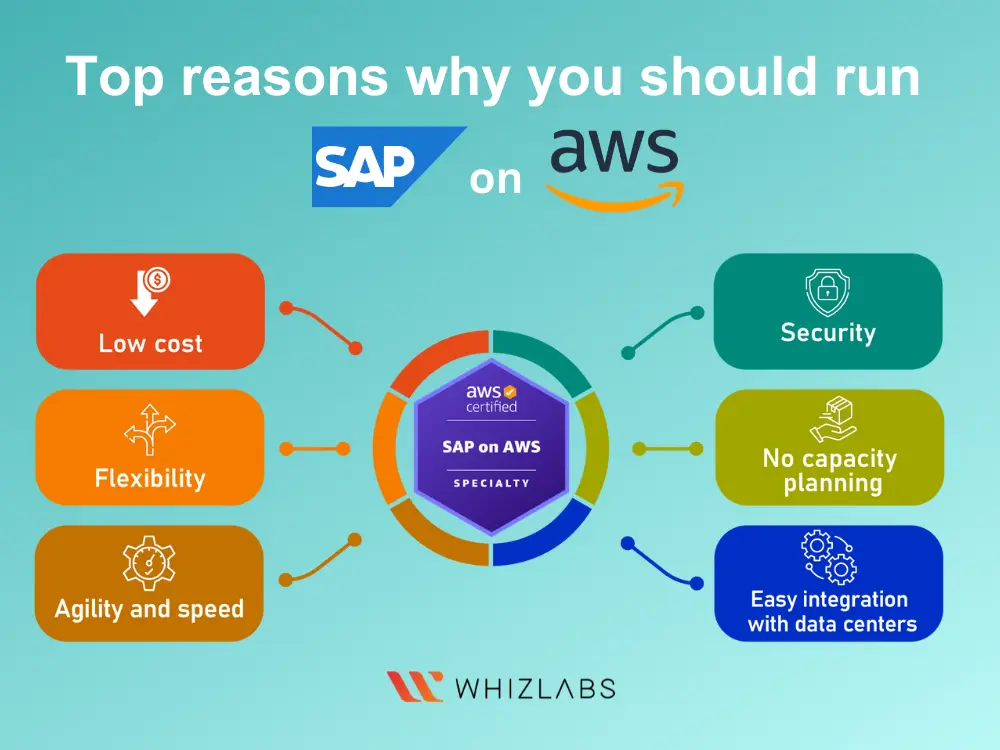In today’s world, streamlining operations and reducing uncertainties in a business need scalable and robust scalable solutions. Here comes a leading ERP solution such as SAP for planning software products, which helps to align business operations and helps end users extract greater results from ERP systems.
Nowadays, many companies integrate SAP with cloud networks to achieve benefits in terms of performance and cost.
In this blog post, we delve into SAP solutions on Amazon, reasons for running SAP on AWS, SAP Cloud benefits, best practices for SAP on AWS, and how they relate to SAP on AWS Certification.
Let’s dive in!
What is SAP on AWS?
When you run SAP on AWS, you can use the same tools Amazon uses to make its customers happy. You also get access to the newest AWS IoT and AI tools, along with a bunch of AWS-specific stuff that can help you make SAP better.
If you run SAP HANA on AWS Cloud, you need not worry about infrastructure management. You will get frequent updates and gain access to innovative technologies used in your business.
Many companies are choosing to use AWS for hosting SAP because it’s proven to be reliable for running important business applications. AWS has put a lot of effort into making sure they have data centers nearby, strong systems that rarely go down, and excellent security measures. This makes companies feel more comfortable about using a public cloud like AWS without worrying too much about safety and control.
What is meant by AWS regions and availability zones?
Region
A region in AWS is like a separate group of AWS services in a certain part of the world. Each region follows the local privacy laws and rules. You have to pick which region your data stays in, and Amazon won’t change it.
The reason for having different regions is that you can plan your web apps to be in the region closest to your customers or where it fits the legal and rule requirements. Plus, each region has at least two separate areas called availability zones.
Availability Zones
Availability zones are special parts inside a region. They work independently and don’t get messed up if something goes wrong in another availability zone. They also make it cheap and fast for different parts of a region to connect.
Top reasons why you should run SAP on AWS
Even though there are various reasons for SAP AWS integration, here I have listed the main reasons for running the SAP on AWS as follows:
- Low cost: By running the SAP on AWS, the costs spent on infrastructure management and operating costs can be minimized. Also, you can get detailed insights on cost savings when you operate on the SAP on AWS rather than going for on-premise.
- Flexibility: AWS can help to scale up the system infrastructure in required pathways. For instance, the availability of resources can be increased in your system for carrying out batching jobs overnight or month-end closing. It significantly increases the scaling capability.
- Agility and speed: When you operate the SAP on AWS, you can be able to launch the SAP systems within milliseconds without a larger investment for SAP system settings. In this way, the entire internal process can be avoided from hardware ordering to operating system setting.
- Security: If you rely on the AWS platform, the SAP applications will be in safer modes by just passing the various security certifications and audits to check whether the platform meets compliance requirements.
- No capacity planning: If you run the SAP on AWS, you don’t need to carry out capacity planning. Instead of this, you can add up processing, network instances, or storage as needed. It means you do not need to plan this, you can simply order from the Amazon platform.
- Easy integration with data centers: Establishing the connection between the AWS and data center to ensure a secured connection for your data and applications is now possible with the usage of Amazon Virtual Private Cloud (VPC).
Also Read : Which AWS Services can be used to migrate workloads of SAP on AWS cloud?
Best Practices for SAP on AWS
The deployment of SAP applications and workloads on AWS can be a tedious and time-consuming process. Also, each SAP migration to AWS found to be a unique process, so it is necessary for the companies to get consultation from the SAP on AWS experts and must follow the guidelines for successful SAP implementation in AWS.
Here are some best practices to get started with PAS-C01 exam:
High availability as a top priority: SAP is found as a mission-critical application for running business operations. And thus designing the SAP architecture on the AWS with higher reliability and availability. To do this, you can make use of this global infrastructure that comprises 99 Availability Zones within 31 geographic regions.
You can also utilize the other services and AWS offerings such as AWS Elastic Load Balancing and auto-scaling capability to achieve resilience and better elasticity.
Right-sizing the AWS resources: To utilize the value from the SAP network, right-sizing the AWS resources whether it is computing, networking, or storage. To put an end to this, partnering with a reliable SAP on AWS partner can help to abstract the complexities that exist in the deployment process.
However, if your team can take care of it, then you must analyze the resource requirements for the demanding SAP workloads. Carrying out performance analysis and testing can help to pick the right resources and maintain the cost overflow.
Maintain Security Compliance: It’s vital to ensure the security of your SAP applications and workloads within the AWS platform. To do this, follow the best security practices recommended by AWS. Establish correct configurations for security groups, network ACLs, and AWS Identity and Access Management (IAM) policies to effectively control who can access your SAP systems.
To protect sensitive data, use encryption methods, such as AWS Key Management Service (KMS) for data at rest and SSL/TLS certificates for data in transit. Moreover, make sure to regularly update and patch your SAP systems to promptly address any potential security vulnerabilities.
SAP S/4HANA Quick Start on AWS for Fast Deployment: AWS offers a tool called Quick Start for SAP S/4HANA that streamlines and speeds up the process of deploying SAP software in the cloud. With Quick Start, you can get your SAP S/4HANA workloads up and running on AWS in just a few hours, a significant improvement compared to manual deployment, which can take days or even weeks. Besides SAP S/4HANA, there are also Quick Start options available for SAP HANA and SAP NetWeaver.
Strategically Utilize Migration Tools: AWS provides a variety of tools and methods to assist businesses in migrating their SAP software solutions to AWS efficiently and with automation. Some noteworthy tools include AWS Launch Wizard for SAP, AWS Migration Hub Orchestrator, Amazon EC2 Instance Resize, AMIs, AWS Snowball, Amazon S3 Transfer Acceleration, Migration Using DMO with System Move, SAP HANA Classical Migration, and more.
Pros of Running SAP on AWS
We all know that AWS is one of the leading industries in cloud computing and SAP partners. But the issue is what are the benefits that can be experienced by the business from migrating SAP to AWS Cloud? Let’s look at the AWS cloud benefits for SAP:
SAP on AWS Advantages
Cost Savings
Companies can minimize the costs in the infrastructure as well as TCO costs by migrating SAP to AWS. SAP reports that every system landscape gets influenced by the AWS usage for hosting ranging from 59-71% over a 5-year lifecycle. The AWS cost savings for SAP increased the performance level.
When it comes to cost elements, research shows that the companies have experienced savings in investment in hardware and software, deployment, upgrading costs, and continuous improvement.
Reliable Infrastructure
Amazon’s Global Infrastructure spans 25 regions and encompasses 80 availability zones. This extensive reach is particularly valuable for global enterprises as it allows them to strategically design their applications, ensuring they are situated near their customers and aligned with local legal and regulatory requirements.
Innovation Potential
When you choose to run SAP on AWS, you gain access to the same tools that Amazon leverages to enhance its customer experiences. This includes access to cutting-edge AWS IoT and AI tools and services, as well as a rich library of AWS-native offerings that can drive innovation within your SAP environment.
It’s worth noting that AWS prioritizes customer feedback in their development process, with a remarkable 90% of their new features and services being inspired by customer input. This commitment means you can expect regular updates that are specifically designed to help you continually improve your SAP operations.
Data Security
In today’s business landscape, data privacy and security are paramount concerns for every company. AWS addresses these concerns with a robust security framework, boasting an impressive 90 security standards and compliance certifications.
Additionally, AWS ensures 100% encryption capability across all of their services that currently store customer data, providing you with peace of mind when it comes to safeguarding your information.
FAQs
What are the benefits of running SAP on AWS?
Organizations opt for migrating SAP applications to AWS for various reasons, including cost-efficiency, dependable infrastructure, increased innovation potential, and enhanced data security.
Can SAP run on AWS?
Most SAP solutions deployed on AWS typically follow a bring-your-own-software and bring-your-own-license (BYOL) approach. Utilizing AWS for your SAP systems doesn’t necessitate acquiring new or specialized SAP licenses. If you are already an SAP customer, you can continue to use your existing SAP licenses when running SAP on AWS.
Which AWS certification is best for SAP basis?
To learn the basics of SAP, you’ll need to take AWS Certified: SAP on AWS – Specialty (PAS-C01) certification. By taking SAP on AWS Certification, you can become familiar with the SAP deployment and management concepts.
Why run SAP on the cloud?
Deploying SAP on the cloud comes with the advantage of having built-in, automated backups to safeguard your data. This not only boosts security but also simplifies the process of data retrieval in case of security breaches or data loss incidents. Furthermore, a cloud platform such as Azure guarantees that SAP data can be accessed by users from any location and at any time.
Conclusion
Hope you have gained a comprehensive understanding of SAP on AWS, its advantages, and the recommended practices for deploying SAP on the AWS platform.
If you want to get enough knowledge about AWS SAP, you can go for SAP on AWS Certification. Having this certification can level up your skills related to the deployment and management of SAP systems on the AWS platform.
Preparation is key for clearing up SAP on AWS Certification and thus you can refer to some preparation stuff like SAP on AWS Study guides, SAP on AWS Practice tests, and so on.
Furthermore, you can grab AWS hands-on labs and AWS sandboxes to sharpen your practical skills.
- Top 25 AWS Data Engineer Interview Questions and Answers - May 11, 2024
- What is Azure Synapse Analytics? - April 26, 2024
- AZ-900: Azure Fundamentals Certification Exam Updates - April 26, 2024
- Exam Tips for AWS Data Engineer Associate Certification - April 19, 2024
- Maximizing Cloud Security with AWS Identity and Access Management - April 18, 2024
- A Deep Dive into Google Cloud Database Options - April 16, 2024
- GCP Cloud Engineer vs GCP Cloud Architect: What’s the Difference? - March 22, 2024
- 7 Ways to Double Your Cloud Solutions Architect Role Salary in 12 Months - March 7, 2024


